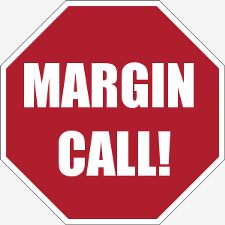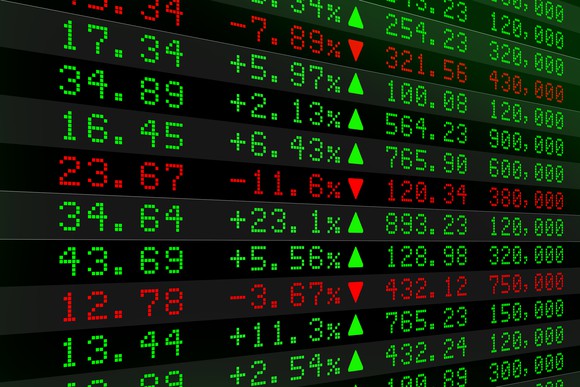Many traders use only technical analysis as their tool kit for trading, no reading of company news, what the company does, no looking at the economy or any other factors. Just what has happened in the past with relation to the price and volume (the amount bought and sold), with a view of predicting the future.
I personally don’t believe in using only technical analysis as I don’t feel you can predict how a company’s share price will perform based solely on a few technical indicators and complex formulas. That said there are a handful of techniques I do use in order to identify trends, support and resistance.
Trends look at the overall direction a share price is moving in. Support is where the price of a share should / could / maybe will have difficulty falling through. The price could bounce or be prevented from falling further. Resistance is the exact opposite to support and it’s where a share price could face difficulty pushing through or getting past. These three can be an important factor when making a decision on when to buy or sell shares because you may not, for example want to buy a share when it is near a perceived resistance level as you may be concerned that the price will not increase much further. You may however want to buy near levels of support in the hope that the support holds and helps to propel the share price higher. I for one want to buy a share when it’s trend is going up rather than down!

Types of Support / Resistance
The are two ways in which support or resistance levels can be estimated.
Historical – these types you gauge by looking at things like previous price highs and lows. Predictive – these are levels of support or resistance that are estimated based on technical indicators, some of which we will take a look at below. Historical Support
As you can see in the example below, CELLO has been supported by the 83p price in 2014 on three occasions in the last year. On the third occasion it dipped slightly under 83p but as you can see it did in fact bounce up almost straight away. In my opinion the nature of support is that the more times it’s tested, the more likely it is to break but when the lows are not quite as low as the previous lows, it can be seen as a good time to potentially buy.
Example 1 – Historical Support. Graph source: ADVFN
If a support level does break it can then flip to become a new resistance level where the price struggles to break through again.
Historical Resistance
Conversely to historical support, is historical resistance. This can form when a share price has hit a level and fallen back again. It’s possible that this level becomes resistance for any future tests. The example below shows how the FTSE 100 has faced resistance in the 6900 area for the last 3 years.
Example 2 – Historical Resistance. Graph source: ADVFN
Predictive Support and Resistance
As I’ve already mentioned, there are a multitude of techniques, theories and formulas which look to predict future price action based on historical price and volume. I use a few techniques but only a tiny subset of what is out there. Mainly because they don’t all correlate with each other, some I have no idea how to use and if it’s so complicated that I can’t understand it, I’m not going to be able to meaningfully use it!
In the blog I will gradually cover all the techniques I use and others that I have come across which seem sensible but for now I will stick to a couple of simple, easier to understand techniques to get started with.
Trend Lines
The easiest predictive technical analysis to understand (for me anyway) are trendlines. They are not only the simplest for me but also my favourite. I love buying into a stock when there is a seemingly obvious upward trend. This can of course change and sometimes if you’re unlucky, it can as soon as you decide to buy but I feel like my chances are better if it is already trending upwards.
Take a look at the National Grid (NG.) Example 3 below. It doesn’t take much science or expertise to see that between 2010 and 2014 the company share price has pretty much gone in one direction. If you were to decide you wanted to buy into National Grid, one of the techniques you could use to time an entry would be by looking at support and resistance trendlines. Ideally you won’t want to buy near the top of what’s known as the channel, as the price has more potential to bounce down from this towards support. It’s around support you where you’d ideally want to buy in. The way you use trend lines is to extend them into the future to see where future support and resistance may lie.
Example 3 – Trend Lines. Graph Source: ADVFN
You’ll note that this is certainly not an exact science and history isn’t always going to repeat itself.
Tips when using trend lines:
Look at more than one time frame and make it appropriate for your style of trading/investing – in Example 1 the 5 year trend shows one trend but it’s possible for there to be trends in different time frames. For example if you’re a day trader you’re not going to be interested in a trend line for 5 years, or maybe not even 1 year or 6 months. You’ll be looking at trends for 1 minute, 5 mins up to 1 hour. These intra-daily trends are going to be very different to any monthly or yearly ones. The steeper the trend line, the less likely it is to hold true for very long for both support and resistance. A trend requires at least 2 points, but the more points which hit a trend, the more validity it holds. The trend line doesn’t need to hit all points, you may get the odd spike up or down out of the trend due to short term volatility but that doesn’t necessarily invalidate the trend. Don’t try and look for trends where none exist – generally it should be fairly obvious if there is a trend, so don’t try and look for something that isn’t there. Avoid buying near the top of the channel. Consider buying near the bottom of a rising channel. Remember a trend isn’t likely to last forever and some may only last a matter of minutes or days (depending on what timeframe you are looking at).Well that about covers the basics of trends, in my next technical analysis post I’ll cover the basics of Moving Averages, which are a little more complex but still fairly easy to understand.










 In very general terms a margin is a border, an edge of something. However, in the financial world, the word margin has a slightly different meaning. Namely, the margin, in this case, is related to the collateral we have mentioned previously. The margin is used to cover the credit risk the margin trader poses for the lender. Essentially, it is the sum of money that you would have to ensure from your funds. The margin can vary greatly, which usually depends on the resource in question. For an example, a margin for currency futures is usually quite low. In fact, it would rarely get over 6 percent of the total value of the contract. However, if stocks were in question they would require quite a bit more. To be a bit more precise, you would usually have to cover at least 30 percent of the value and up to one half of it. One should bear in mind that the margin requirement will always follow the stock and how volatile it is. The more volatile the stock in question is, the higher the requirement will be.
In very general terms a margin is a border, an edge of something. However, in the financial world, the word margin has a slightly different meaning. Namely, the margin, in this case, is related to the collateral we have mentioned previously. The margin is used to cover the credit risk the margin trader poses for the lender. Essentially, it is the sum of money that you would have to ensure from your funds. The margin can vary greatly, which usually depends on the resource in question. For an example, a margin for currency futures is usually quite low. In fact, it would rarely get over 6 percent of the total value of the contract. However, if stocks were in question they would require quite a bit more. To be a bit more precise, you would usually have to cover at least 30 percent of the value and up to one half of it. One should bear in mind that the margin requirement will always follow the stock and how volatile it is. The more volatile the stock in question is, the higher the requirement will be.












